>>> English text below <<<
Nelle ultime settimane ho lavorato alla realizzazione dell’immagine manifesto dell’edizione 2024 di The Others Art Fair, la fiera indipendente nata con l’obiettivo di intercettare il linguaggio delle nuove generazioni, che presenta durante la settimana delle arti torinese alcune delle più innovative espressioni artistiche nazionali e internazionali.
Il tema scelto per l’edizione 2024 è il XXI Arcano maggiore dei Tarocchi: Il Mondo.
Questa carta è considerata uno degli arcani più importanti dei Tarocchi: è la realizzazione totale, rappresenta pienezza, riuscita e armonia.
Quando ho ricevuto la richiesta di lavorare a una carta dei Tarocchi, il pensiero è andato indietro di un po’ di anni. Il primo mazzo di Tarocchi me lo ha regalato mia mamma da ragazzina, senza troppi significati né particolari carichi spirituali o esoterici: era in allegato a una rivista di psicologia a cui era abbonata e le carte avevano dei bei disegni, quindi finirono senza clamore nel caos della mia scrivania.
Durante le trasferte dei miei genitori, trascorrevo le sere d’infanzia con le mie tre prozie a guardare su una piccola emittente televisiva locale una cartomante che faceva i Tarocchi in diretta telefonica. Ricordo ancora l’accento marcatamente piemontese e la solennità con cui la conduttrice bionda con i capelli cotonati e la maglia di paillettes leggeva nelle carte le situazioni amorose, economiche e lavorative del pubblico di provincia. Alle zie piaceva commentare e anticipare il verdetto della cartomante, a volte ci prendevano, altre volte si limitavano a dire che la Silvana o la Patrizia di turno avrebbero dovuto lasciarlo uno così, altro che chiedere il parere alla cartomante, te lo dicevano loro: valigia fuori dalla porta e via andare.
Nella mia famiglia la divinazione era un fatto come un altro, non destava particolare stupore che la nonna sognasse cose che poi in qualche forma accadevano, che le sue amiche leggessero la fortuna e la sfortuna nelle forme che l’olio d’oliva assumeva in piatti contenenti acqua, o che la prozia andasse al fiume a controllare il grado di consunzione di determinate erbe lasciate a macerare sotto una pietra, per capire quanto ci sarebbe ancora voluto affinché quella verruca presa in piscina scomparisse dal mio piede. Man mano che l’erba si consumava, era previsto che si consumasse di pari passo anche la verruca, fino a sparire del tutto.
La nonna usava un ciuffetto di finocchio passato sulla mia fronte (quelli del suo orto, i finocchi che siamo abituati a vedere al supermercato sono candidi e glabri) per stabilire, in base a quanto velocemente si sciupava, quanto fossi “affascinata”, cioè quanto mi fossi caricata di negatività altrui, spesso inconsapevole.
Ho capito solo in seguito che tutte quelle pratiche avevano, almeno concettualmente, delle basi in comune con sistemi più celebri di divinazione come l’I Ching o i Tarocchi: un particolare stato emotivo poteva essere letto attraverso il comportamento di un medium in un determinato momento di interrogazione, quindi l’olio, il ciuffetto di finocchio o le erbe sotto alla pietra non erano altro che una fotografia del momento. Ciò che accade in un dato momento assume la qualità peculiare di quel momento.
Il secondo mazzo di tarocchi me lo sono comprato da sola in Erasmus. È stato foriero di innumerevoli nottate casalinghe con amiche care, a partire dal rito serale del tiraggio della "carta della buonanotte”, seguito da discussioni infinite e spesso sconclusionate, fumando e bevendo litri di tè, rito mantenuto con inaspettata costanza durante quasi tutto l’anno passato in Spagna, nonostante le feste e le esistenze disordinate. Ci eravamo imposte di tirarne solo una al giorno, per non assuefarci e per non mancare di rispetto all’oracolo interpellandolo senza profondità.
Quel mazzo dai disegni naïf, che ancora conservo, oltre a svelare quelle che al momento sembravano importanti epifanie, ha contribuito a saldare rapporti che durano ancora oggi, a distanza di vent’anni, nonché ha dato un grosso contributo alla mia pratica del castigliano.
La fase successiva è stata segnata dalla scoperta dell’I Ching, nelle vesti del mio amatissimo Adelphi nell’edizione corredata delle tre monete per la divinazione. Questo oracolo mi ha accompagnata in svariate fasi della vita, non c’è stata decisione importante che non abbia preso senza aver sentito quello che aveva da dirmi. L’I Ching è stato anche fondamentale per la stesura della mia tesi di laurea: un’improbabile trattato sulla casualità nel gesto artistico e sulla sua interpretazione per comprenderne l’essenza.
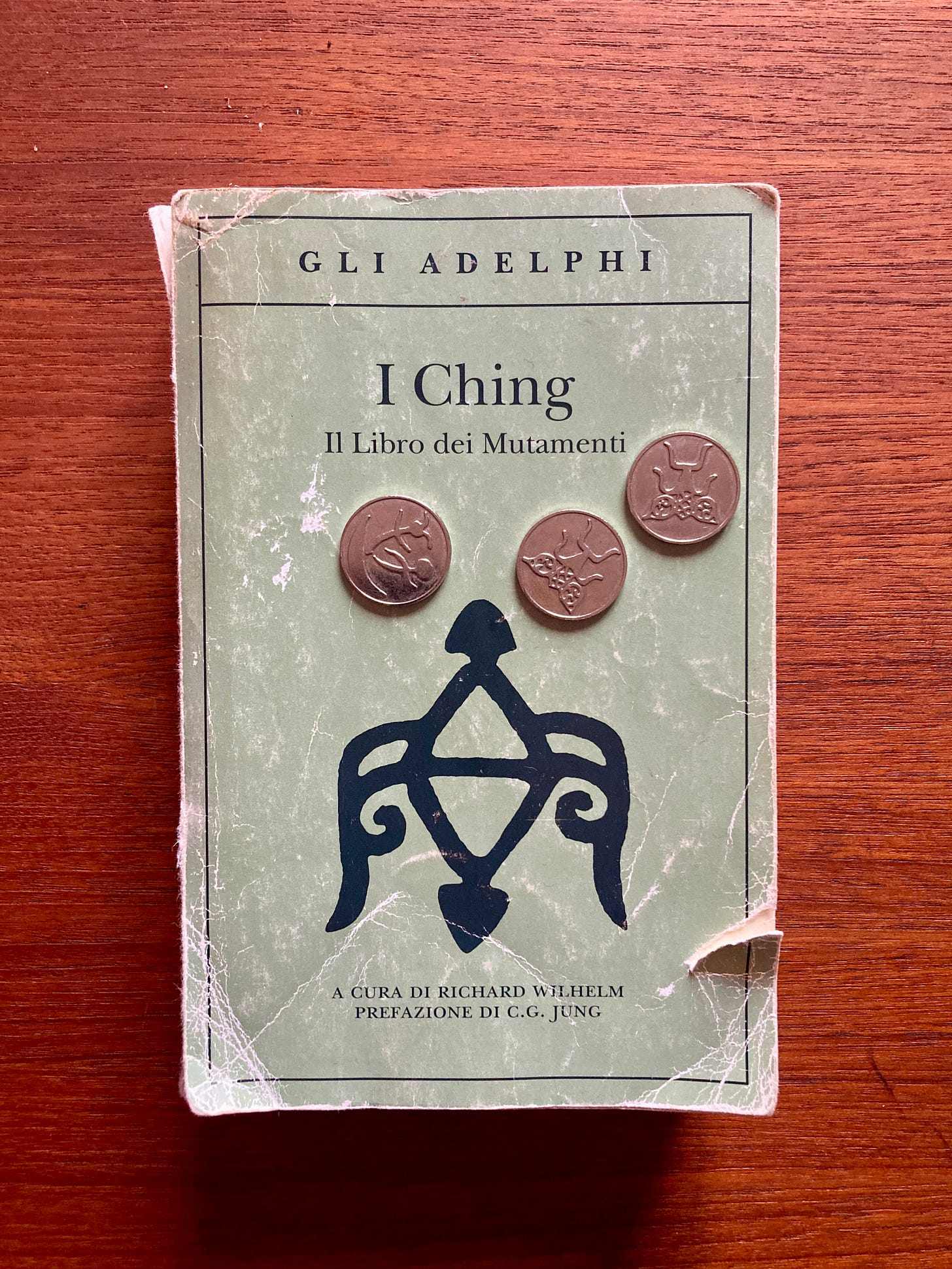
Tornando al presente e alla carta del Mondo, mi sono approcciata a questa immagine lavorando per sintesi a partire dall’iconografia del tarocco di Marsiglia, una tra le rappresentazioni più antiche dell’immagine.
Ho ricondotto l’immagine all’essenza, mantenendo centrale la figura di donna che danza e la mandorla che la contiene, conosciuta anche nell’iconografia sacra come Mandorla Mistica o Vesica Piscis, la cui rappresentazione si ritrova frequentemente nelle lunette dei portali delle cattedrali tardo-romaniche e gotiche, a contenere figure religiose.
Secondo alcuni miti greci poi, la mandorla sarebbe anche la vulva della Dea Cibele, venerata in Anatolia come la Grande Dea Madre, quindi riconducibile al concetto di fecondità e di conseguenza simbolo universale di creazione e creatività.
Si possono vedere molte assonanze della carta con il Cristo in Maestà, un’immagine contenuta in un manoscritto medievale tedesco, conservato presso la Baden State Library a Karlsruhe, in Germania.
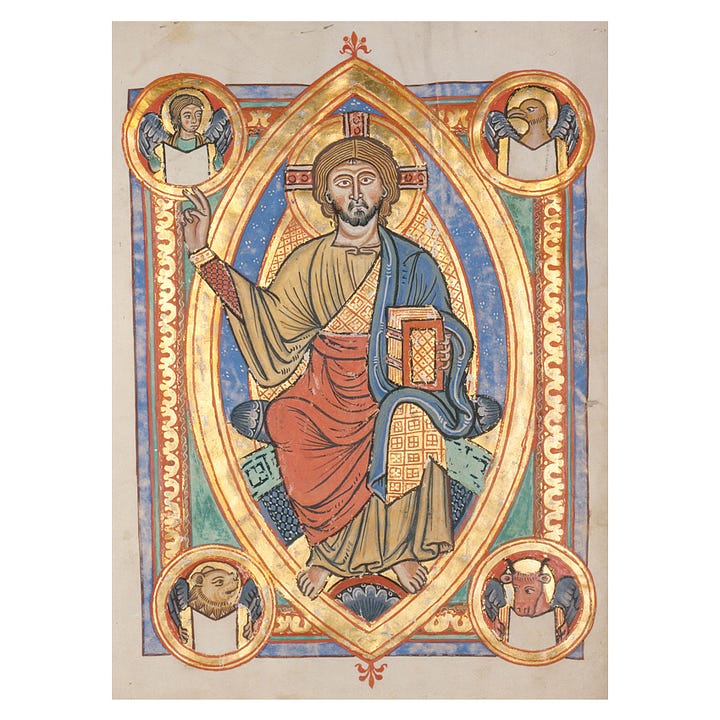
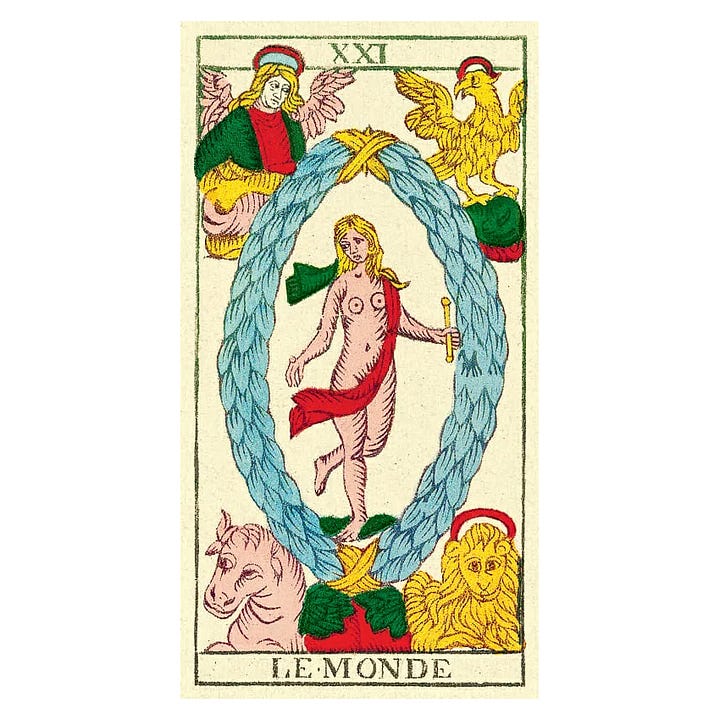
I metodi di divinazione hanno un fascino trasversale, hanno affascinato le mie prozie negli anni ’80 ma sono anche stati oggetto d’interesse da parte di illustri studiosi.
Carl Gustav Jung individua delle analogie tra l’I Ching (di cui scrisse la celebre prefazione a cura di di Richard Wilhelm, pubblicato da Adelphi) e la divinazione con le carte.
“L’uomo sempre ha sentito la necessità di trovare un accesso attraverso l’inconscio al significato di una condizione presente, i tarocchi possono essere dunque visti come un compendio di immagini simboliche e psicologiche, simboli con cui si gioca, come l’inconscio sembra giocare con i suoi contenuti.
Al pari del I Ching, esse si combinano in certi modi, e le differenti combinazioni corrispondono al giocoso sviluppo degli eventi nella storia dell’umanità.
Ci sono ventuno carte sulle quali ci sono simboli, o raffigurazioni di situazioni simboliche; queste sono una sorta di idee archetipiche, che si mescolano ai componenti ordinari del flusso dell’inconscio, per cui adatte a un metodo intuitivo che ha lo scopo di comprendere il flusso della vita, forse anche predire eventi futuri, eventi che si presentano alla lettura delle condizioni del momento presente.”
(Da: Vision: Notes of the Seminar given in 1930-1934 by C.G.Jung - Visioni: note del seminario tenuto nel 1930-34 da C.G. Jung, curato da Claire Douglas).
L’illustrazione che ho realizzato ispirata alla carta del Mondo è stata dipinta in originale con china indiana su fogli di acetato trasparente sovrapposti, asportando le parti in negativo con punte, per ottenere segni di carattere incisorio.
La tavola originale sarà esposta durante i giorni della manifestazione presso ILO, in viale Maestri del lavoro 10 a Torino.
Per l’occasione è in lavorazione anche una serigrafia a colori con inserti in foglia oro in tiratura limitata, firmata e numerata. La foglia oro è presente sulla stella che fluttua sulla mano della donna, omaggio a quella situata sulla punta della Mole Antonelliana.
La serigrafia è prenotabile da ora in prevendita con un coupon che dà diritto a uno sconto del 20% riservato agli iscritti alla newsletter:
Basterà inserire in fase di checkout il codice ILMONDO20
Il coupon è utilizzabile entro il 13 ottobre 2024.
La serigrafia sarà poi consegnata a partire dal giorno 31 ottobre 2024.
Per chi visiterà The Others sarà possibile anche il ritiro a mano presso la Galleria Caracol presente in fiera, oppure su appuntamento nel mio studio a Torino (in questi due casi l’ordine va fatto selezionando “local pick up”, in modo da decurtare le spese di spedizione).
Per chi sarà a Torino durante la settimana delle arti contemporanee ci si vedrà per mostre, per tutti gli altri arrivederci alla prossima newsletter!
Vi lascio con il link a questo podcast dedicato al mondo dell’illustrazione a cura di Alessandro Mele a cui sono stata invitata qualche tempo fa:
THE WORLD
XXI Major Arcana of the Tarot, new illustration
In recent weeks I have been working on the creation of the poster image for the 2024 edition of The Others Art Fair, the independent fair created with the aim of intercepting the language of new generations, which presents some of the most innovative national and international artistic expressions during the Turin arts week.
The theme chosen for the 2024 edition is the 21st Major Arcana of the Tarot: The World.
This card is considered one of the most important arcana in the Tarot: it represents total fulfillment, wholeness, success and harmony.
When I received a request to work on a Tarot card, my thoughts went back a few years. The first Tarot deck was given to me by my mom as a young girl, without too much meaning or special spiritual or esoteric overtones: it was enclosed with a psychology magazine she subscribed to, and the cards had nice designs, so they ended up quietly in the chaos of my desk.
During my parents' trips away, I used to spend childhood evenings with my three great-aunts watching on a small local TV station a fortune-teller doing Tarot cards live over the phone. I still remember the distinctly Piedmontese accent and the solemnity with which the blond-haired anchorwoman with backcombed hair and sequined top read into the cards love, economic and work situations of the provincial audience. The aunts liked to comment on and anticipate the fortune teller's verdict, sometimes they got it right, other times they would simply say that the Silvana or Patrizia of the moment should have left a guy like that. Without asking the fortune teller's opinion, they would tell you: suitcase out the door and go away.
In my family, divination was as much a matter of course as anything else; it was not particularly surprising that my grandmother would dream of things that then happened in some form, that her friends would read fortune and misfortune in the forms that olive oil took in dishes containing water, or that my great-aunt would go to the river to check the degree of consumption of certain herbs left to soak under a stone, to see how much longer it would take for that wart caught in the pool to disappear from my foot. As the herb wore off, it was expected that the wart would wear off at the same rate until it disappeared altogether.
Grandma used a tuft of fennel passed over my forehead (the ones from her garden, the fennels we are used to seeing in the supermarket are white and glabrous) to determine, based on how quickly it would scar, how “fascinated” I was, that is, how much I had loaded myself with other people's negativity, often unconsciously.
I realized only later that all those practices had, at least conceptually, some basis in common with more famous systems of divination such as the I Ching or the Tarot: a particular emotional state could be read through the behavior of a medium at a given moment of questioning, so the oil, the tuft of fennel or the herbs under the stone were nothing more than a snapshot of the moment. What happens at a given moment takes on the peculiar quality of that moment.
The second tarot deck was bought by myself in Erasmus. It was the harbinger of countless home nights with dear friends, beginning with the evening ritual of drawing the “goodnight card,” followed by endless and often rambling discussions, smoking and drinking gallons of tea, a ritual maintained with unexpected constancy during almost the entire year spent in Spain, despite the parties and messy existences. We had imposed on ourselves to pull only one a day, so as not to get addicted and not to disrespect the oracle by questioning it without depth.
That deck of naïve designs, which I still keep, not only unveiled what seemed at the time to be important epiphanies, but also helped to weld relationships that still last today, twenty years later, as well as made a major contribution to my practice of Castilian Spanish.
The next phase was marked by the discovery of the I Ching, in the guise of my beloved Adelphi in the edition accompanied by the three divination coins. This oracle has accompanied me through various stages of life; there was no important decision I did not make without hearing what it had to say. The I Ching was also instrumental in the writing of my thesis: an unlikely treatise on randomness in the artistic gesture and its interpretation to understand its essence.
Returning to the present and the World map, I approached this image by working by synthesis from the iconography of the Marseille tarot, one of the oldest representations of the image.
I traced the image back to its essence, keeping central the figure of a dancing woman and the almond containing her, also known in sacred iconography as the Mystic Almond or Vesica Piscis, whose representation is frequently found in the lunettes of the portals of late Romanesque and Gothic cathedrals, containing religious figures.
According to some Greek myths then, the almond is also said to be the vulva of the Goddess Cybele, worshipped in Anatolia as the Great Mother Goddess, thus traceable to the concept of fertility and consequently a universal symbol of creation and creativity.
One can see many similarities of the card with Christ in Majesty, an image contained in a medieval German manuscript, preserved at the Baden State Library in Karlsruhe, Germany.
Divination methods have a cross-cultural appeal; they fascinated my great-aunts in the 1980s but have also been the subject of interest by distinguished scholars.
Carl Gustav Jung identifies similarities between the I Ching (for which he wrote the famous preface edited by Richard Wilhelm, published in Italy by Adelphi) and card divination.
“Man has always felt the need to find an access through the unconscious to the meaning of a present condition, the tarot cards can thus be seen as a compendium of symbolic and psychological images, symbols with which one plays, as the unconscious seems to play with its contents.
Like the I Ching, they are combined in certain ways, and the different combinations correspond to the playful development of events in human history.
There are twenty-one cards on which there are symbols, or depictions of symbolic situations; these are a kind of archetypal ideas, mingling with the ordinary components of the flow of the unconscious, so suitable for an intuitive method that aims to understand the flow of life, perhaps even predict future events, events that arise upon reading the conditions of the present moment.”
(From: Vision: Notes of the Seminar given in 1930-1934 by C.G.Jung - Visions: notes of the seminar given in 1930-34 by C.G. Jung, edited by Claire Douglas).
The illustration I made inspired by the World card was painted in the original with Indian ink on overlapping sheets of transparent acetate, removing the negative parts with sharp instruments, in order to obtain marks of engraving character.
The original panel will be on display during the days of the event at ILO, at 10 Maestri del Lavoro Avenue in Turin.
Also in the works for the occasion is a color silkscreen print with gold leaf inserts in a limited edition, signed and numbered. Gold leaf is featured on the star floating on the woman's hand, an homage to the one located on the tip of the Mole Antonelliana, Turin most known historical building.
The screen printing can be pre-ordered now with a coupon that entitles you to a 20% discount reserved for newsletter subscribers:
Simply enter the code ILMONDO20 during checkout.
The coupon can be used until October 13, 2024.
The silkscreen will then be delivered starting October 31, 2024.
For those who will visit The Others, it will also be possible to pick up by hand at the Caracol Gallery present at the fair, or by appointment at my studio in Turin (in these two cases, the order must be placed by selecting “local pick up,” in order to deduct shipping costs).
For those who will be in Turin during Contemporary Arts Week we will see each other for exhibitions, for everyone else see you in the next newsletter!

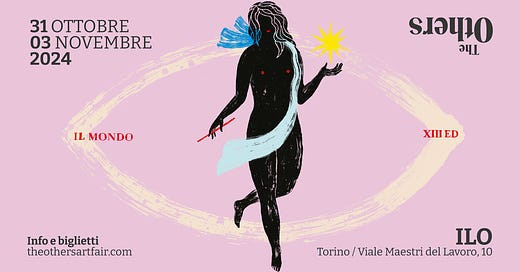



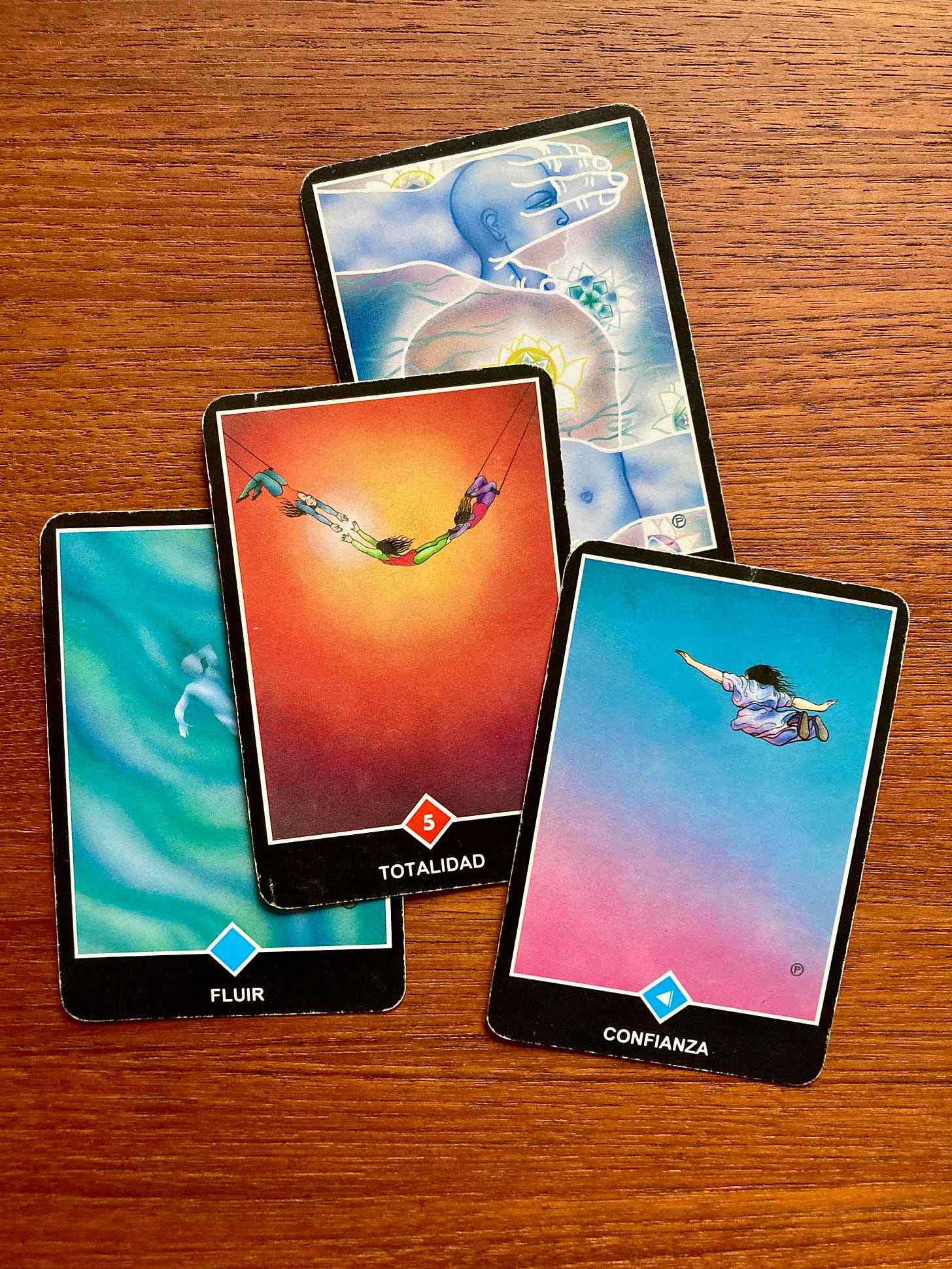


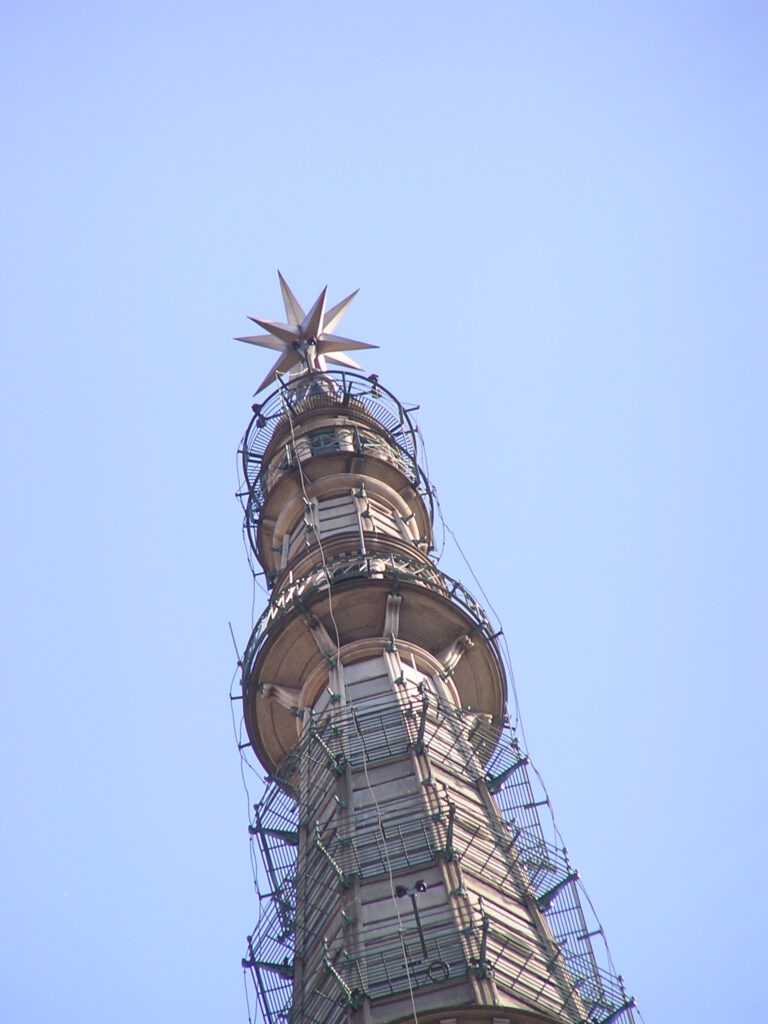
Scrivi benissimo e amo la tua visione dei Tarocchi. Grazie del link. Attenzione: "a cura di di Richard Wilhelm". Inoltrerò la tua newsletter a mio marito illustratore.